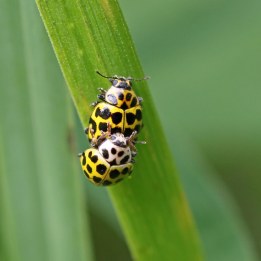Tags
Halyzia 16-punctata, harlequin ladybird, Harmonia axyridis, ladybird, ladybird larva, ladybird lifecycle, ladybird pupa, Orange ladybird
Just like every other insect, a ladybird goes through a complete transformation during its short, one-year life but the various stages are something I’ve only become aware of this year so I thought I’d share them with you.
Adult ladybirds spend the cold winter months in a dormant state, awakening in the springtime as the weather begins to warm up. After munching away on some aphids to get their juices flowing again, they look for a member of the opposite sex and mate. I don’t have any egg photos but they are, apparently, bright yellow and are laid on the underside of leaves. Once the mating and egg-laying are complete, the adult ladybirds die.
Depending on the temperature and weather conditions, the eggs hatch after 3 to 10 days and the little larvae immediately begin eating: scale insects and aphids are their favourites so you can see why gardeners love them. At this stage, they look nothing at all like ladybirds, though they do have unique patterns – left and centre above are Harlequins (Harmonia axyridis) and the one on the right is an Orange (Halyzia 16-punctata).
After 3 to 4 weeks of constant eating, the larvae pupate, shedding their larval skin and changing into this strange-looking blob you can find attached to the tops of leaves. The metamorphosis from larvae to adult ladybird only takes 7 to 10 days – a miracle really!

When the adult ladybird first emerges from its pupa, it is very pale and takes a little while for its final colours to show, though you can usually see traces of its spots. And that’s it! The adult will trundle around the leaves, eating all those pesky aphids until the winter months come, and the whole process will begin all over again.








Pingback: It’s a miracle! | earthstar
Nice post. I love your yellow ladybirds. Haven’t seen many of any colour or spottage here this year. Did you photograph the Harlequins in Cardiff? I saw them in several places in London last year, but so far not here yet, thankfully. Don’t suppose they’ll be long.
LikeLiked by 1 person
The little yellows are cuties but quite shy – scurry away as soon as they spot me.
The Harlequins were all photographed in Cardiff – they’re prolific here. By far the most common ladybird I see, unfortunately.
LikeLiked by 1 person
Love!! Didn’t know this! 😍
LikeLiked by 1 person
Thanks very much. 🙂
LikeLike
I have never known what ladybird larvae looked like (I would not even have known that I was looking at a ladybird!)… thank you for your post, it is most informative!
LikeLiked by 1 person
I’m glad my post was useful. Thanks, Laura. 🙂
LikeLike